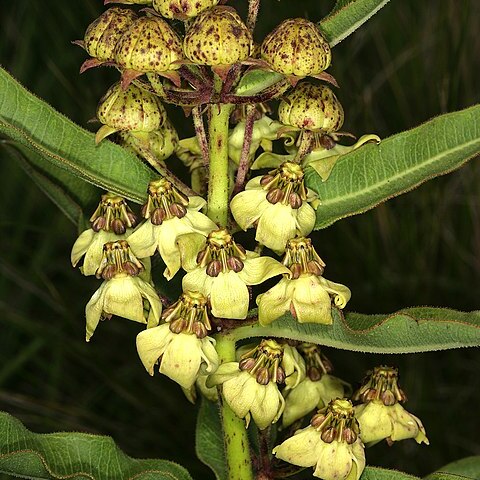Tuberous-rooted perennial, tuber as long as stem or longer. Stem 300-1060 mm tall, medium to very stout, simple or branched at the base, frequently with more than one stem arising from the same rootstock, ± glabrous to scabrous or pubescent, rarely subtomentose, hairs usually bifarious. Leaves ascending-spreading; petiole 3-12(-15) mm long; blade 32-127(-140) x 10-58(-65) mm, narrowly oblong, narrowly oblong-ovate or narrowly elliptic to elliptic, ovate or broadly oblong, rarely suborbicular, margins scabrous or pubescent, surfaces ± glabrous to scabrous or pubescent. Inflorescence umbellate, 3-6(-10)-flowered, sessile but the lowermost usually pedunculate, at nodes and terminal; peduncules up to 35 mm long, ± glabrous to scabrous or pubescent. Bracts 2-12 mm long, narrowly linear, narrowly lanceolate or lanceolate, ovate, acuminate, pubescent or scabrous below, deciduous. Pedicels 15-35(-45) mm long, ± glabrous to scabrous or pubescent. Sepals 6.0-7.0 x 2.8-8.5 mm, lanceolate or narrowly ovate, rarely elliptic or oblong, acute or acute-acuminate, glabrous or rarely puberulous near the apex above, pubescent below. Corolla 11-24(-28) mm long, lobed almost to the base, dirty greenish-whit hairs giving the surface a velvet-like appearance above, puberulous to pubescent below; lobes 8-22(26) x 7-14 mm, reflexed-spreading, elliptic, oblong or ovate, rarely narrowly ovate-lanceolate, apex acute or obtuse and usually notched, margins revolute. Corona lobes 2.0-7.5 mm long, 2.0-6.2 mm high at the base, lanceolate, ovate or oblong, with a pair of contiguous fleshy keels 0.5-3.7 mm high, 1.0-7.0 mm long, obtuse, subdeltoid, usually extending to, or almost to, the apex, rarely slightly beyond the apex, which if prolonged beyond the keels is obtuse, recurved, horizontal or upcurved; sometimes the keels are very reduced and the lobes are small, spreading, scarcely projecting beyond the anther wings, recurved at the shortly pointed apex with the reduced keels forming a cut-like groove along the upper face, keels and corona lobes whitish-dull green often tinted with purple. Anther wings 3.0-8.6 mm long, slightly oblique, outer edge more or less straight or slightly concave with basal angle curved outwards; appendages 2.0-4.5 mm long, narrowly ovate or oblong to broadly ovate or suborbicular, tip acute or obtuse, erect at the base and then curved over and covering the style apex. Follicles 80-100 mm long, globe-shaped, weakly ridged, green with mauve markings.
More
Perennial, geophytic herb, 390-680 mm long; stems 1 or 2, erect, unbranched. Leaves spreading, elliptic to oblong, 59-82 x 16-36 mm, base cuneate to shortly attenuate, apex rounded to acute with slight mucronate point or acuminate, margins almost revolute; petioles 3.6-9.2 mm long. Inflorescences 2-6-flowered; peduncles up to 7 mm long. Corolla reflexed, greenish to white, tinged purple; lobes lanceolate, free for most of length, margins revolute, 11.0-15.4 x 6.5-8.5 mm. Corona pale green or cream-coloured; lobes 2.1-4.5 mm high, 0.9-3.8 mm long, globular with 2 fleshy wings on proximal upper surface. Flowering time Nov.-Jan. Follicles globose, glabrous, 5-winged; pedicels twisted.
A robust, erect herb. It grows 90 cm tall. The stem is slightly flattened and hairy. It grows from a tuberous rootstock. The leaves are large, simple and opposite. They have short stalks and are oblong to round. There are bristly hairs on both surfaces. The flowers are in groups at the nodes. The flowers are large and 20-25 mm long. They are greenish white with a tinge of purple. The fruit is a narrow follicle.
Perennial herb, 0.30-1.06 m high. Leaf margins flat. Corolla lobes reflexed-spreading. Corona lobes with a pair of fleshy keels that extend to apex or slightly beyond. Flowers dirty greenish white, often slightly tinted with purple; corona whitish dull green often tinted with purple.

